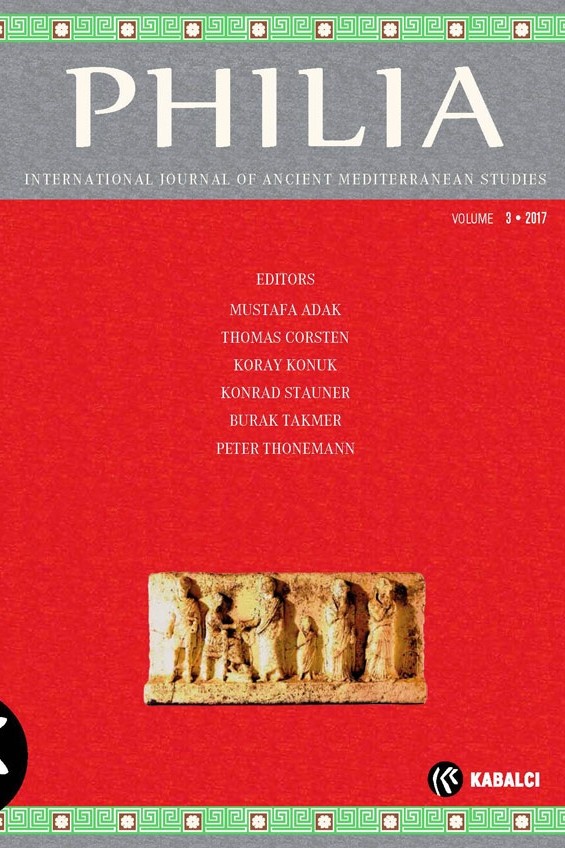Bir parthenos’un Yaşı. Aphrodiasias’tan yeni bir Mezar Yazıtı
Aphrodisias’tan İ.S. 2. yy.da Melition Tatia için
hazırlanmış yeni bir onurlandırma yazıtında “parthenos çağında öldü” ifadesi
yer almaktadır. Παρθένος sözcüğü genel olarak bünyesinde aynı anda pekçok anlam
barındırmaktadır: bekaret, evlenmemiş olma statüsü ve gençlik. Aphrodisias’tan
bu yeni belge bize parthenos’un “yaş kategorisi” olarak ilk anlamını
hatırlatmaktadır. Zira pekçok yazıtta parthenos sözcüğü bakireliğe değil yaşa
işaret etmektedir.
Anahtar Kelimeler:
Parthenos; yaş; Aphrodisias; heykel kaidesi; gymnasion
The Age of a parthenos. A new Epitaph from Aphrodisias
A new posthumous honorific inscription from
Aphrodisias (2nd cent. CE) for Melition Tatia uses the expression ‘she died at
the age of a parthenos’. Usually, παρθένος denotes multiple things at the same
time: virginity, unmarried status, and youth. The new text from Aphrodisias
reminds us of the primary meaning of parthenos is the age class of girls. In
many inscriptions parthenos does not refer to virginity but to age.
___
- Bourtzinakou 2012 I. Bourtzinakou, Die Prosopographie von Aphrodisias, Hei-delberg 2012 (http://archiv.ub.uni-heidelberg.de/volltextserver/13639).
- Brelich 1969 A. Brelich, Paides e parthenoi, Rome 1969.
- Brulé 1987 P. Brulé, La fille d’Athènes. a religion des filles à Athènes à l'époque classique; mythes, cultes et société, Paris 1987.
- Campanile 1994 M. D. Campanile, I sacerdoti del Koinon d'Asia (I sec. a.C.-III sec. d.C.), Pisa 1994.
- Chaniotis 2013 A. Chaniotis, Second Thoughts on Second Names in Aphro-disias, in: R. Parker (ed.), Personal Names in Ancient Anato-lia, Oxford 2013, 207–229.
- Chaniotis, forthcoming A. Chaniotis, Das kaiserzeitliche Gymnasion in Aphrodisias, in: P. Scholz – D. Wiegand – W. Habermann (eds.), Das kai-serzeitliche Gymnasion, Berlin (forthcoming).
- Connelly 2007 J. B. Connelly, Portrait of a Priestess. Women and Ritual in Ancient Greece, Princeton 2007.
- Giannopoulos 2008 N. Giannopoulos, Ὁ θεσμὸς τῆς γερουσίας τῶν ἑλληνικῶν πόλεων κατὰ τοὺς Ρωμαϊκοὺς Χρόνους, Thessaloniki 2008.
- Merkelbach – Stauber 2001 R. Merkelbach – J. Stauber, Steinepigramme aus dem griechischen Osten, Bd. II, Munich 2001.
- Parker 2005 R. Parker, Athenian Religion: A History, Oxford 2005.
- Robert 1937 L. Robert, Études anatoliennes. Recherches sur les inscrip-tions grecques de l’Asie Mineure, Paris 1937.
- Robert 1969 L. Robert, Les inscriptions, in: J. des Gagniers et al., Laodicée du Lycos: Le Nymphée. Campagnes 1961–1963, Paris 1969, 247–389.
- Roueché 1993 C. Roueché, Performers and Partisans at Aphrodisias in the Roman and Late Roman Periods, London 1993.
- Sissa 1990 G. Sissa, Greek Virginity, Cambridge 1990.
- Smith et al. 2006 R. R. R. Smith et al., Roman Portrait Statuary from Aphrodisias, Mainz am Rhein 2006.
- Stracca 1996/97 B. M. Palumbo Stracca, Hybris barbarica e sophrosyne greca: l’épitafio per Domitilla, Romanobarbarica 14, 1996–1997, 15–32.
- Ziebart 1914 E. Ziebart, Aus dem griechischen Schulwesen, Leipzig 19142.
- ISSN: 2149-505X
- Başlangıç: 2015
- Yayıncı: Kabalcı Yayıncılık
Sayıdaki Diğer Makaleler
Bithynia ve Pontos’ta Grup ve Dernekler’in Yerel Siyasetçi ve Eyalet Valileriyle İletişimleri
Portulanlar ve Portulan Haritaları Işığında Hellespontos ve Bithynia Sahilleri
Silifke Müzesi’nde Erken Bizans Ağırlıkları
Asia, Galatia ve Lycia-Pamphylia Eyaletleri Sınırında Phrygia Paroreios ve Pisidia
Frigce’de Mezar ve Mezar Yapılarının Adlandırılması Üzerine
Dünyanın En Eski Şanzıman Tasviri. Phrygia Hierapolisi’nden «Daedalos» ve Mucit Ammianos
Phaselis’ten İmparator Lucius Verus İçin Yeni Bir Adak Yazıtı
Antik Literatürden Örneklerle Akdeniz Dünyasında Kybele Kültü
Bolu’dan Caracalla Dönemi’ne ait bir ad fines Miltaşı
Karia’da Yunanca Epigramlar – Yerli Nüfusun Helenleşmesine dair Veriler
